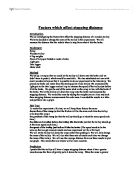Factors which affect stopping distance
Introduction
We are investigating the factors that affect the stopping distance of a wooden trolley. We have decided to change the mass of the trolley in this experiment. We will measure the distance that the vehicle takes to stop from when it hits the brake.
Equipment
Ramp
Wooden trolley
4 1kg weights
Piece of A4 paper folded to make a brake
Light gate
Data logger
Meter stick
Method
We set up a ramp so that we could let the trolley roll down onto the brake and we didn’t have to push it, which would be unreliable. We also substituted real cars with small wooden trolleys so that it is possible to do our experiment in the laboratory. We placed our brake one meter from the starting point of our trolley. We connected the light gate to the data logger and set it up to measure the speed of the trolley just before it hit the brake. We put the end of the meter stick on the ramp in line with the back of the brake. We let the trolley roll down the ramp onto the brake and measured the stopping distance. We varied the mass by adding the weights one at a time and took three stopping distance measurements for each mass. I recorded the results in a table and put them into a graph.







